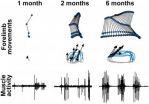Their study, being presented at the annual meeting of the Society for Neuroscience in San Diego, showed that children and adolescents, ages 8 to16, who show fear when looking at happy faces on a screen inside an fMRI scanner were those who had least success with an eight-week course of cognitive behavioral therapy.
Conversely, children who showed fear while looking at fearful faces benefitted from the treatment, which is also known as talk therapy, the researchers found.
"Anxiety and fear are intrinsically linked, so how the brain's fear center responds would naturally affect how anxiety disorders manifest," says the study's lead author, Steve Rich, a fourth year medical student.
"Indeed, the impact on their responses to therapy was impressive," he says. "Past studies have shown that many people react to fearful faces with fear themselves, but our most robust finding indicated that some anxiety disorder patients have more anxiety towards happy faces than fearful ones, and those patients were the least likely to respond to cognitive behavioral therapy."
The study enrolled 13 boys and 10 girls in this study, all of whom had been diagnosed with pediatric anxiety disorder.
While inside the fMRI machine, the participants were shown pictures of faces that expressed certain emotions strongly. "The questions we were trying to answer were: What emotions make people afraid when they witness them on others' faces, and does that pattern predict response to talk therapy," Rich says.
An fMRI is a type of scan that records changes in blood flow being used at each location in the brain, thus showing levels of activity. In this study, the researchers zeroed in on the amygdala, a brain structure known to represent the emotion of fear.
They then correlated the differing responses they saw in the amygdala with outcomes from an eight-week course in cognitive behavioral therapy.
The researchers found a significant correlation, indicating that pre-treatment fMRI can be used to select patients who likely do well with talk therapy alone, and those that may require other therapy, such as medication.
Rich says that one explanation for the results is that those patients who have greater anxiety towards happy faces than towards fearful ones have a subtly different disorder, one that is very similar but cannot be treated by cognitive behavioral therapy.
"In this subset of patients, that support may actually elicit even more anxiety, thus alienating them from the therapist," he says. "Further study is required to determine whether this is indeed a unique disease subtype, or whether a modified approach to cognitive behavioral therapy that requires the therapist to stay completely neutral could make therapy more effective for these patients."
Rich and his co-authors do not expect that every pediatric anxiety disorder patient should receive an fMRI diagnosis.
"fMRI is expensive, and this study does not by any means suggest that it should be used as a universal screening tool," he says. "Even so, once the field develops further, our results suggest that neuroimaging studies like fMRI may be able to help us understand why a given patient might not be responding to the first-line treatment. In other words, when routine care is not enough, we can focus on the nuances of the individual."
INFORMATION: Support for this research was provided to Rich during a summer research fellowship at the National Institute of Mental Health.
About Georgetown University Medical Center
Georgetown University Medical Center is an internationally recognized academic medical center with a three-part mission of research, teaching and patient care (through MedStar Health). GUMC's mission is carried out with a strong emphasis on public service and a dedication to the Catholic, Jesuit principle of cura personalis -- or "care of the whole person." The Medical Center includes the School of Medicine and the School of Nursing and Health Studies, both nationally ranked, the world-renowned Georgetown Lombardi Comprehensive Cancer Center and the Biomedical Graduate Research Organization (BGRO). In fiscal year 2009-2010, GUMC accounted for 79 percent of Georgetown University's extramural research funding.
Abstract: 160.11/U9
Predicting cognitive-behavioral therapy outcomes for pediatric anxiety disorders using fMRI
*S. RICH1, D. PINE2, M. ERNST2, J. CAMERON2, D. LUCKENBAUGH3, A. ZAMETKIN2, E. NELSON2, B. JUSTEMENT3;
1Georgetown Univ. Sch. of Med., Arlington, VA; 2Natl. Inst. of Mental Hlth., Rockville, MD; 3NIH, Rockville, MD
Determining the appropriate treatment methodology for pediatric anxiety disorder patients can be difficult, as some will require pharmacological intervention while others require only psychotherapy (also known as "talk therapy"). This latter group of patients has decreased in size among the psychiatric patient population due to the robust effects of pharmaceuticals; however, the long-term effects of these agents, including the most popular among them - the SSRIs - are not clear, and some animal studies have suggested potential deleterious effects. As a result, those patients who could be successfully managed on psychotherapy alone would benefit from doing so. Unfortunately, identifying such patients has been difficult to date. In this study of 23 pediatric patients with anxiety disorders, we used pre-treatment fMRI data obtained while observing faces from an internationally-standardized set designed to represent discrete emotions, and correlated their physiological reactions to these faces (specifically, the level of activation in the amygdala - a known locus of visceral fear response) with their ultimate treatment outcomes after an 8-week course of cognitive-behavioral therapy (CBT), a well-established and evidence-supported psychotherapeutic treatment methodology. Our findings demonstrated a significant correlation, indicating that pre-treatment fMRI data can be used to stratify patients into those who are likely to respond robustly to psychotherapy, and those who are likely to require additional alternative intervention.

